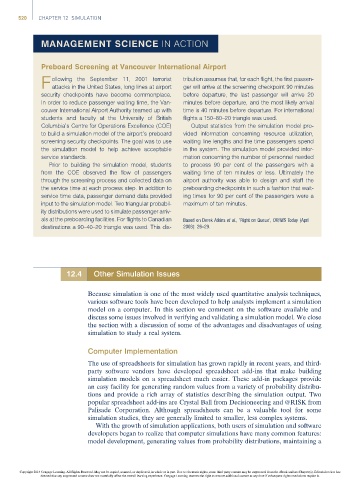Page 540 -
P. 540
520 CHAPTER 12 SIMULATION
MANAGEMENT SCIENCE IN ACTION
Preboard Screening at Vancouver International Airport
ollowing the September 11, 2001 terrorist tribution assumes that, for each flight, the first passen-
F attacks in the United States, long lines at airport ger will arrive at the screening checkpoint 90 minutes
security checkpoints have become commonplace. before departure, the last passenger will arrive 20
In order to reduce passenger waiting time, the Van- minutes before departure, and the most likely arrival
couver International Airport Authority teamed up with time is 40 minutes before departure. For international
students and faculty at the University of British flights a 150–80–20 triangle was used.
Columbia’s Centre for Operations Excellence (COE) Output statistics from the simulation model pro-
to build a simulation model of the airport’s preboard vided information concerning resource utilization,
screening security checkpoints. The goal was to use waiting line lengths and the time passengers spend
the simulation model to help achieve acceptable in the system. The simulation model provided infor-
service standards. mation concerning the number of personnel needed
Prior to building the simulation model, students to process 90 per cent of the passengers with a
from the COE observed the flow of passengers waiting time of ten minutes or less. Ultimately the
through the screening process and collected data on airport authority was able to design and staff the
the service time at each process step. In addition to preboarding checkpoints in such a fashion that wait-
service time data, passenger demand data provided ing times for 90 per cent of the passengers were a
input to the simulation model. Two triangular probabil- maximum of ten minutes.
ity distributions were used to simulate passenger arriv-
als at the preboarding facilities. For flights to Canadian Based on Derek Atkins et al., ‘Right on Queue’, OR/MS Today (April
destinations a 90–40–20 triangle was used. This dis- 2003): 26–29.
12.4 Other Simulation Issues
Because simulation is one of the most widely used quantitative analysis techniques,
various software tools have been developed to help analysts implement a simulation
model on a computer. In this section we comment on the software available and
discuss some issues involved in verifying and validating a simulation model. We close
the section with a discussion of some of the advantages and disadvantages of using
simulation to study a real system.
Computer Implementation
The use of spreadsheets for simulation has grown rapidly in recent years, and third-
party software vendors have developed spreadsheet add-ins that make building
simulation models on a spreadsheet much easier. These add-in packages provide
an easy facility for generating random values from a variety of probability distribu-
tions and provide a rich array of statistics describing the simulation output. Two
popular spreadsheet add-ins are Crystal Ball from Decisioneering and @RISK from
Palisade Corporation. Although spreadsheets can be a valuable tool for some
simulation studies, they are generally limited to smaller, less complex systems.
With the growth of simulation applications, both users of simulation and software
developers began to realize that computer simulations have many common features:
model development, generating values from probability distributions, maintaining a
Copyright 2014 Cengage Learning. All Rights Reserved. May not be copied, scanned, or duplicated, in whole or in part. Due to electronic rights, some third party content may be suppressed from the eBook and/or eChapter(s). Editorial review has
deemed that any suppressed content does not materially affect the overall learning experience. Cengage Learning reserves the right to remove additional content at any time if subsequent rights restrictions require it.

